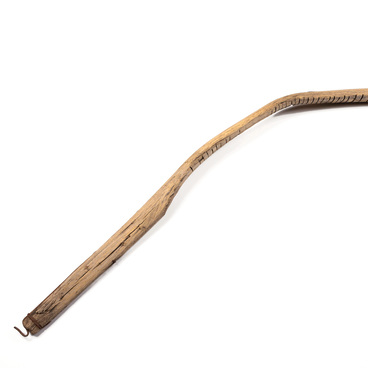Spinning and weaving represent one of the key traditional women’s occupations. The most labor-intensive process in producing fabrics is making its warp threads. To make that, the raw materials need to be collected first: the wool, flax, nettle, and hemp. Then it was processed, and only after that did the painstaking process of spinning the threads begin.
After cleaning and drying the plant materials, they had to be threshed. Then it was soaked, and after drying it was then crushed, ruffled, and scratched. To give the fibers the maximum degree of softness and flexibility, they were also sometimes ground in a mortar. The preparation process for spinning wool took significantly less time than the preparation work on the plant fibers. After shearing the sheep, the wool was washed, taken apart by hand, and then dressed with a special tool: a comb.
The comb was used not only for dressing the wool, but also to comb the tow from various plant materials. Usually, the comb was made from a piece of aspen, birch, or other wood. On a blade ranging from 20–45 centimeters wide, teeth from 20–25 centimeters long were cut, and the blade itself turned into a handle about 80–90 centimeters long. Large combs had a stand that attached to the bottom, and sometimes they were also used during the spinning of threads. In the process of work, the comb was placed on the edge of the bench so that the teeth remained behind the bench, and the handle that the spinner sat on was on the bench. In her right hand, the woman took a handful of fiber, lowered it onto the teeth of the comb, and pulled it between them.
Preparing the fiber was finished with one more combing using a special comb: a dressing comb. Also, this process was carried out on a large wooden comb while using another comb that was smaller, and made of wood or bone. After they were combed, the tow was twisted into small bundles. Only then could the craftswomen start spinning the threads.
The method of spinning itself originated a long time ago. Initially, the yarn was twisted by hand, but later the spindle was invented, and then the hand spinning wheel appeared. It is commonly known that spinning wheels were used in India more than 2,000 years ago. By the 15th century, improved versions of spinning wheels, treadle spinning wheels, had spread throughout Europe, which greatly simplified the production of threads. However, due to the high cost of the treadle spinning wheel, not every peasant farm could afford to have one.
After cleaning and drying the plant materials, they had to be threshed. Then it was soaked, and after drying it was then crushed, ruffled, and scratched. To give the fibers the maximum degree of softness and flexibility, they were also sometimes ground in a mortar. The preparation process for spinning wool took significantly less time than the preparation work on the plant fibers. After shearing the sheep, the wool was washed, taken apart by hand, and then dressed with a special tool: a comb.
The comb was used not only for dressing the wool, but also to comb the tow from various plant materials. Usually, the comb was made from a piece of aspen, birch, or other wood. On a blade ranging from 20–45 centimeters wide, teeth from 20–25 centimeters long were cut, and the blade itself turned into a handle about 80–90 centimeters long. Large combs had a stand that attached to the bottom, and sometimes they were also used during the spinning of threads. In the process of work, the comb was placed on the edge of the bench so that the teeth remained behind the bench, and the handle that the spinner sat on was on the bench. In her right hand, the woman took a handful of fiber, lowered it onto the teeth of the comb, and pulled it between them.
Preparing the fiber was finished with one more combing using a special comb: a dressing comb. Also, this process was carried out on a large wooden comb while using another comb that was smaller, and made of wood or bone. After they were combed, the tow was twisted into small bundles. Only then could the craftswomen start spinning the threads.
The method of spinning itself originated a long time ago. Initially, the yarn was twisted by hand, but later the spindle was invented, and then the hand spinning wheel appeared. It is commonly known that spinning wheels were used in India more than 2,000 years ago. By the 15th century, improved versions of spinning wheels, treadle spinning wheels, had spread throughout Europe, which greatly simplified the production of threads. However, due to the high cost of the treadle spinning wheel, not every peasant farm could afford to have one.



